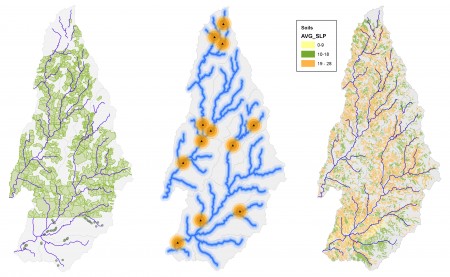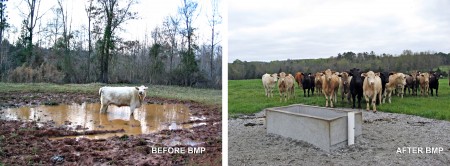Water and Environmental Quality
RPI has conducted a broad range of field studies to characterize point and non-point pollution of water, sediments, and aquatic organisms. Selected examples of experience in this area included:
SC DHEC (South Carolina Department of Health and Environmental Control) through a federally funded (Environmental Protection Agency) cost-sharing program awarded seven Grants to RPI to implement Total Maximum Daily Loads (TMDL) for fecal coliform bacteria and turbidity in 13 SC watersheds. RPI’s responsibilities under this Grant include: 1) conducting geospatial analyses to identify agricultural lands that had the most impact on water quality within the watersheds by identifying hot spots of concern in which to focus cost-share efforts (Figure 1); 2) implementation of environmentally sound watering structures, wells, waterlines, creek exclusion fencing, and other Best Management Practices (BMPs) in order to restore water bodies on agricultural lands (Figure 2); 3) repairing failing septic systems; and 4) community outreach on how to solicit additional participation either through Grant monies, other Federal programs, or on a volunteer basis to improve farm practices and restore watersheds in the local community and beyond. In twelve years, RPI has implemented Best Management Practices in 13 watersheds, providing support to farmers and landowners with $2.1 million of restoration funding ($1.2 million in federal funding/$0.9 million in-kind match from numerous partners).
Figure 1. Examples of output from geospatial analyses of agricultural density, hydrologic buffers around State water quality monitoring stations, and topography conducted to target likely sources of watershed impairment in SC watersheds.
Figure 2. Example of Best Management Practices (BMPs) implemented (e.g., environmentally sound water structures, creek exclusion fencing) to mitigate fecal coliform and turbidity loading into SC watersheds.


